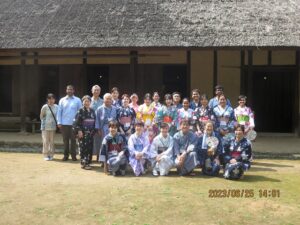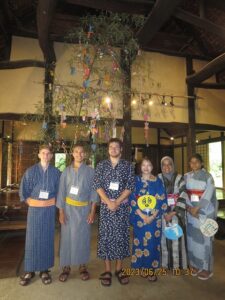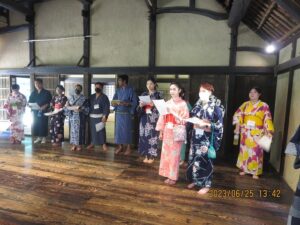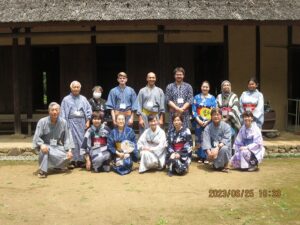
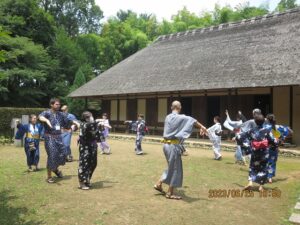
Date & Time: Sunday, June 25, (Part 1) 10:00 a.m.-12:20 p.m. (Part 2) 1:20 p.m.-3:40 p.m.
Place: Tsuzuki Minka-en, Folk House Garden
Participants: 19 international students at Yokohama National University and Tokyo Institute of Technology (five from Philippines, four from China, two each from Switzerland and India, one each from Indonesia, Mongolia, Germany, Sri Lanka, America, and Malaysia)
Attendants: 15 KSGG members
Languages: English and Japanese
Report by Fumie, KSGG
KSGG holds an annual event called “Yukata Kai” for international students. In this event, the students wear yukatas, (traditional Japanese summer kimono), then decorate strips of colored paper called tanzaku for Tanabata Star festival, enjoy Tanabata celebration and Japanese folk dances.
The weather is very worrisome issue for this event in the rainy season, but fortunately the sky was very clear all day long. The students chose their favorite patterns of yukata immediately after their arrivals. Those yukatas had been prepared by KSGG volunteers. Then the volunteers helped the students get dressed in yukata quickly. All of them in kimono looked very happy while chatting with each other: “I wore a kimono when I traveled in Kyoto,” “I was really looking forward to wearing a yukata.” After that, all of the students wrote their wishes on tanzakus in their own languages and hung them on the bamboo tree prepared by Minka-en staff. They had cut the bamboo tree in the grove behind the house and the KSGG volunteers had arranged their handmade decorations on the bamboo tree two days before the event. Brush type calligraphy pen is difficult even for Japanese people to use, however every student could use it very well. Afterwards, they listened with great interest to explanations in English and Japanese about the Tanabata festival and Japanese folk dance. Then they sang “Tanabata song” along to beautiful melody on the CD while looking at the hiragana lyrics cards. After singing “Tanabata song”, they went out into the garden for Japanese folk dance. The weather was fine but it was very humid. So right after dancing “Tokyo Ondo” only two times, everyone got drenched in sweat and had to take a 5-minute break to drink water. The second dance “Tanko-bushi” began in the shade, but everyone was sweating a lot again, so returned into the house to prevent heatstroke.
In the afternoon, as light cloud kept sun out, we could dance both “Tokyo Ondo” and “Tanko-bushi” twice. They enjoyed the Japanese folk dances with smiling and were attracted by the unique movement. While dancing “Tanko-bushi” they were chanting “Dig, Dig (scoop up coals)”. Before taking off their yukatas, they went to the bamboo grove for taking photos as well as Otsuka-Saikachido Relics Park. For keeping the event on schedule, KSGG volunteers accompanied with each small group of the students. In spite of the very short tour for 20 minutes, KSGG volunteers also had great chance to communicate with the students. After changing their clothes, they expressed their impressions of this event: “I am happy to wear a yukata,” “the Tanabata decorations is fun” “the folk dance is interesting,” and “it was a very valuable experience for me to learn about Japanese culture.” This “Yukata Kai” was well-received by the students and great successful.
Following are “Thank you messages” from the students.
1)Thank you very much for inviting me to the Yukata event today. I had a wonderful time there with all the friendly KSGG members and fellow tutees. I had lots of fun singing and dancing and also wearing Yukata was a unique experience for me. I am very grateful for KSGG for organizing sure a wonderful event. I look forward to participating in other KSGG events in the future. Thank you very much again.
2) I really enjoyed this event. When I first met KSGG members wearing yukata at the station, I felt sure that today’s event would be so fantastic. I felt grateful that the volunteers helped me change into yukata. As one of us mentioned, it is difficult to tie the obi on the back of the yukata. It is amazing that the volunteers are able to tie it so beautifully. And now I am very interested in Japanese history and culture. So, I am happy to have experiences including writing my wishes, decorating bamboo branches, and joining Japanese folk dances. I also learned a lot from the volunteers when we went to Otsuka-Saikachido Relics Park. It was definitely productive day.
